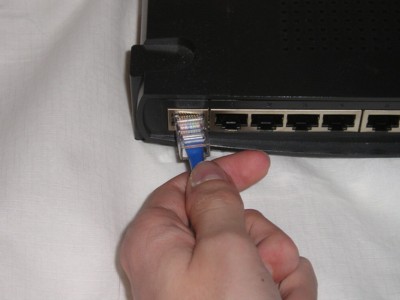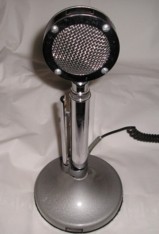
Figure 1. Inserting an Ethernet RJ-45 Plug at an Angle
Abstract: Controlling uncertainty in test data
is very important if the data is to be useful. The case of
insertion of an RJ-45 plug on an Ethernet cable into a jack is used to illustrate how a
hidden uncontrolled variable can affect tests results, in this case
making the results meaningless.
Figure 1 shows an RJ-45 Ethernet plug being inserted into a jack. Note that it is not being held straight, but at an angle. It turns out there is a little play in the jack such that when the plug is inserted at an angle, one pair of the Ethernet connection makes contact first. If the plug is angled in the other direction, the other Ethernet pair will make contact first. If there are electronic circuits connected to one pair and just ground on the other pair through the transformer centertaps, the insertion angle may cause a charged cable to connect to the electronics first or ground first.
During a charged cable test I was conducting, one of the Ethernet pairs was connected to ground and the other to electronics through the centertaps of the Ethernet transformers, If the plug was angled one way, the circuit would survive the highest charge voltage level that could be applied to the cable. When the plug was angled the other way, the circuit would fail at a definite charge voltage on the cable, a much smaller value. Until this was realized, the data was a scatter plot with some ports failing at a much lower voltage than others.
Similar effects can occur on all types of testing where an unknown, that is uncontrolled, variable has significant effects on the outcome of the test. The example used here of an RJ-45 plug and a static charge on the cable is just one possible example.
If the effect of the uncontrolled variable is more subtle than my example here, real trouble can result. The bad data may not be realized as such and result in incorrect decisions on designs or errors in standards. I have seen both.
Summary: Uncontrolled variables in a test can lead to unacceptable uncertainty in the outcome of the test. A sign that this may be happening is data that seems to make no sense. Subtle errors may be even more dangerous.
Discussion: Uncontrolled hidden
variables can cause severe problems in testing of electronic circuits.
The case of cable discharge and RJ-45 connectors makes a case in point.
Electrostatic discharge from Ethernet cables carrying a static charge
has damaged
many Ethernet ports in recent years as a charged cable is connected to
equipment. When electronic circuits are
located outside of the protecting Ethernet transformers, such as when
power is supplied over an Ethernet connection through the transformer
centertaps, protecting the exposed circuitry is very important as is
characterizing the event so adequate protection can be designed into
the circuitry.
Figure 1 shows an RJ-45 Ethernet plug being inserted into a jack. Note that it is not being held straight, but at an angle. It turns out there is a little play in the jack such that when the plug is inserted at an angle, one pair of the Ethernet connection makes contact first. If the plug is angled in the other direction, the other Ethernet pair will make contact first. If there are electronic circuits connected to one pair and just ground on the other pair through the transformer centertaps, the insertion angle may cause a charged cable to connect to the electronics first or ground first.
During a charged cable test I was conducting, one of the Ethernet pairs was connected to ground and the other to electronics through the centertaps of the Ethernet transformers, If the plug was angled one way, the circuit would survive the highest charge voltage level that could be applied to the cable. When the plug was angled the other way, the circuit would fail at a definite charge voltage on the cable, a much smaller value. Until this was realized, the data was a scatter plot with some ports failing at a much lower voltage than others.
Similar effects can occur on all types of testing where an unknown, that is uncontrolled, variable has significant effects on the outcome of the test. The example used here of an RJ-45 plug and a static charge on the cable is just one possible example.
If the effect of the uncontrolled variable is more subtle than my example here, real trouble can result. The bad data may not be realized as such and result in incorrect decisions on designs or errors in standards. I have seen both.
Summary: Uncontrolled variables in a test can lead to unacceptable uncertainty in the outcome of the test. A sign that this may be happening is data that seems to make no sense. Subtle errors may be even more dangerous.
Other articles on this website and other sources related to this topic are:
- January 2006, A Small Change Can Have a Large Effect
- January 2002, Cable Effects Part 1: Cable Discharge Events
Coming soon for private on-site delivery and as a public seminar is my latest single day seminar titled: EMC Lab Techniques for Designers (How to find EMC problems and have some confidence your system will pass EMC testing while it is still in your lab).
Home

